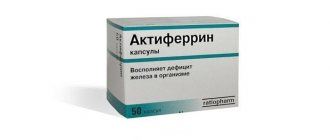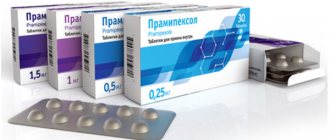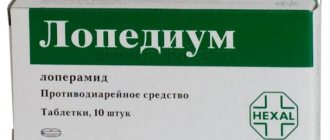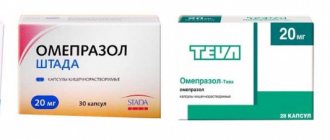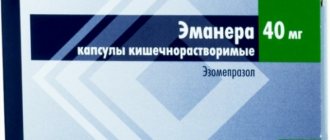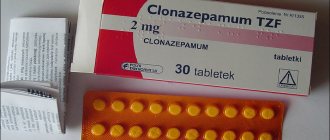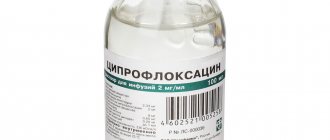Pharmacodynamics and pharmacokinetics
Omeprazole inhibits the proton pump (H+/K+-ATPase) in the parietal (lining) cells of the stomach, thereby blocking the final stage of the formation of hydrochloric (hydrochloric) acid.
The drug begins to act within the first 60 minutes after administration. The effect lasts for the next 24 hours, and it reaches its peak 2 hours after administration.
For duodenal ulcers, taking 0.02 g of the drug allows you to maintain intragastric acidity at a level of 3 for 17 hours. 3-5 days are enough to completely restore secretory activity.
The substance is quickly absorbed from the digestive canal. TCmax varies from 30 to 60 minutes, bioavailability - from 30 to 40%. The drug is approximately 90% bound to plasma proteins and is almost completely metabolized in the liver.
T1/2 - from 30 minutes to 1 hour. Metabolic products are excreted primarily by the kidneys. With chronic renal failure, excretion decreases in proportion to the decrease in Clcr. In the elderly, excretion decreases while bioavailability increases. In case of liver failure, T1/2 is 3 hours with 100% bioavailability.
Medicinal effects
Omeprazole is used to treat stomach ulcers, erosions and inflammations of the upper digestive system. The active ingredients of the medicinal drug suppress the production of hydrochloric acid in the stomach and reduce its activity. The medicine is available in capsule form. Their shell dissolves in the acidic environment of the stomach.
After familiarizing yourself with the action of Omeprazole and its instructions for use, you will understand why it is needed. For example, the medication actively affects the bacterium Helicobacter pylori, which causes stomach and intestinal ulcers.
Omeprazole helps with reflux esophagitis. During abnormal reflux of stomach contents into the esophagus, damage to its walls occurs. The result is ulcers or erosions that are difficult to heal.
Omeprazole reduces the damaging effect of hydrochloric acid, normalizes the pH of gastric juice, and reduces the manifestations of unpleasant symptoms.
The drug significantly alleviates the course of the disease, improves the well-being of the sick person, reduces the risk of the pathology returning and the development of undesirable consequences. Omeprazole begins to act an hour after administration, the therapeutic effect lasts for 24 hours.
Indications for use of Omeprazole
What is Omeprazole capsules for?
Indications for the use of Omeprazole Acri are no different from the indications listed in the annotation of Omeprazole produced by another pharmaceutical company (Sandoz, Gedeon Richter Plc., STADA CIS, etc.). The medicine is effective for:
- benign gastric/duodenal ulcer (including if the disease is associated with taking NSAIDs);
- eradication therapy of H. pylori (in combination with antibacterial drugs);
- GERD;
- prevention of aspiration of acidic gastric contents;
- ulcerogenic adenoma of the pancreas;
- weakening of the symptoms of acid-dependent dyspeptic disorders (the drug helps with heartburn , eliminates heaviness in the abdomen, belching, flatulence , bloating, unpleasant aftertaste and nausea).
What does Omeprazole (Acri, Stada, Sandoz, Richter, etc.) help with these diseases? The drug, acting at the molecular level, suppresses the synthesis of hydrochloric acid by the lining cells of the gastric mucosa and prevents increased secretion after eating.
Thus, when treated with Omeprazole, there is a rapid regression of diseases of the stomach and/or duodenum , the symptoms of dyspepsia and pain go away, and overall well-being improves.
By provoking a persistent decrease in acidity, the drug creates optimal conditions for the successful eradication of H. pylory, which is the cause of 90% of all gastritis and peptic ulcers .
Omeprazole for gastritis
For gastritis , Omeprazole is prescribed only in cases where the patient has increased acidity of gastric secretions.
For hypo- and normoacid gastritis, the use of the drug is contraindicated, since it can provoke thinning of the mucous membrane, a decrease in the number of glands and secretory insufficiency of the stomach with zero acidity of the digestive juice contained in it.
The optimal dose for gastritis is 20 mg/day. Treatment usually lasts from 2 to 3 weeks. If the disease is associated with H. pylori infection, the patient is prescribed antibacterial drugs according to one of the generally accepted regimens for such cases.
Use of Omeprazole for heartburn
Low-dose proton pump inhibitors (PPIs) (for example, Omeprazole Sandoz capsules containing 10 mg of the active substance) are over-the-counter medications that can be used to treat occasional heartburn.
Consultation with a doctor is necessary if:
- the patient develops other symptoms (weight loss, pain in the epigastrium or behind the sternum, dysphagia );
- relapses of heartburn become more frequent.
The oldest and most famous method of relieving heartburn is the use of Al/MgCa containing antacids , the mechanism of action of which is based on the ability to neutralize hydrochloric acid in the lumen of the stomach.
Their only advantage is their speed. The disadvantages are the short-term effect (no more than 1.5 hours), the ability to provoke stool disorders (depending on the composition of the drug, the patient may experience constipation or diarrhea ), side effects associated with the absorption of the ions contained in their composition.
In addition, antacid drugs interact quite aggressively with other drugs, thereby interfering with the absorption of concomitantly taken drugs. For heartburn , which is a manifestation of GERD, the effectiveness of antacids is very low.
Another group of agents that have traditionally been used to treat heartburn are alginates . They do not have a neutralizing effect, but create a mechanical barrier that prevents stomach contents from entering the esophagus.
Despite all the advantages of alginates and antacids , the most effective for heartburn are those that suppress the formation of hydrochloric acid. Before the introduction of PPIs, the most popular drugs were H2-histamine receptor blockers.
Their effect occurs later than the effect of alginates or antacids (this is due to the need for these drugs to enter the systemic circulation), but it persists for 8-12 hours.
The disadvantage of H2-histamine receptor blockers is that for the relief of persistent, recurring heartburn, their use in over-the-counter doses does not always give the desired effect.
Also, when taking H2-histamine blockers in small doses, a phenomenon known as “effect escape” may occur, which may be associated with the development of tolerance to these drugs.
In addition, they - especially the first generation drugs - have a pronounced inhibitory effect on the microsomal oxidation system of the liver and can interact with simultaneously taken drugs (while changing their pharmacokinetic parameters).
H2-histamine blockers potentiate the effects of alcohol, which makes them ineffective for relieving heartburn caused by drinking alcohol.
Currently, the most effective method of treating heartburn (including heartburn that occurs at night) is the use of over-the-counter PPIs containing 10 mg of omeprazole.
The full therapeutic effect of the drug for heartburn is achieved already in the first 4 days, although in some patients the disappearance of symptoms and complete relief are noted already on the first day of using Omeprazole.
The use of small doses of the drug “on demand” for the treatment of non-erosive reflux esophagitis in more than half of patients helps eliminate dyspeptic symptoms for at least six months.
Omeprazole is well tolerated by patients and has a low risk of serious side effects in patients taking it. When taking low doses of the drug, adverse events are usually isolated and characterized by a moderate degree of severity.
The side effects that are described in the Vidal reference book and Wikipedia with long-term use of high doses of PPIs do not occur when taking small doses of omeprazole.
Why is Omeprazole prescribed for pancreatitis?
In chronic pancreatitis, the effectiveness of Omeprazole is due to its ability to reduce intrapancreatic pressure by suppressing secretion and thereby reducing the load on the inflamed and weakened pancreas (PG).
Thus, the purpose of prescribing the drug for pancreatitis is to ensure maximum rest of the pancreas.
In addition, chronic pancreatitis in most cases is complicated by GERD, the main causes of which are impaired motility of the esophagus and stomach, weakness of the esophageal sphincters, as well as hiatal hernia in combination with increased acid secretion in the stomach.
Once in the esophagus, the acidic contents of the stomach provoke heartburn , chest pain, sour taste, reflex cough and increased incidence of dental caries.
Omeprazole helps with heartburn and eliminates other dyspeptic symptoms , significantly alleviating the course of GERD, reducing the intensity of its manifestations and unloading the pancreas. The drug can be used for a long time (from one month to six months or more).
Why is IV Omeprazole prescribed?
IV use of the drug is indicated as an alternative to taking capsules in the following cases:
- treatment and prevention of relapses of duodenal ulcers ;
- treatment and prevention of relapses of stomach ulcers ;
- eradication of H. pylori in peptic ulcer disease (in combination with appropriate antibacterial agents);
- treatment and prevention of peptic ulcer associated with the use of NSAIDs (including in patients at risk);
- therapy for reflux esophagitis (including long-term treatment of patients with an inactive form of the disease);
- treatment of symptomatic GERD;
- treatment of ulcerogenic adenoma of the pancreas .
Side effects
Side effects of the drug appear as:
- dysfunction of the digestive system (abdominal pain, stool disorders, nausea, vomiting, increased activity of liver enzymes, flatulence, taste disturbances, stomatitis , dry mouth, liver dysfunction, hepatitis ).
- Disturbances in the function of hematopoietic organs, the symptoms of which are leuko- , pancyto- , thrombocytopenia, agranulocytosis .
- Disorders of the musculoskeletal system ( myalgia , arthralgia , myasthenia gravis ).
- Skin disorders ( photosensitivity , skin rashes, itching, alopecia , exudative erythema multiforme ).
- NS function disorders: in patients with concomitant severe somatic pathologies, dizziness, headaches, depression or agitation are possible; in patients with previous severe liver disease - encephalopathy .
- Hypersensitivity reactions: bronchospasm , fever , angioedema , urticaria , anaphylactic shock , interstitial nephritis .
- Other disorders: gynecomastia , general malaise, peripheral edema, visual impairment, hyperhidrosis, formation of benign glandular (glandular) cysts in the stomach (pathology develops with long-term use of the drug as a result of suppression of HCl secretion and is reversible).
Omeprazole powder and tablets: instructions for use
Instructions for use Omeprazole-Acri (capsules o/r)
The daily dose of the drug depends on the indications:
- peptic ulcer , esophageal reflux - 20 mg;
- reflux esophagitis - 20, for severe disease - 40 mg;
- prevention of relapse of reflux esophagitis and peptic ulcer - 10 mg (in small doses the drug can be taken for a long time);
- prevention of acid aspiration pneumonitis - 40 mg once an hour before surgery (if the operation lasts more than 2 hours, the patient is advised to re-administer the required dose);
- acid-dependent dyspepsia - 10-20 mg;
- ulcerogenic adenoma of the pancreas - 20-120 mg (if the dose exceeds 80 mg/day, it should be divided into 2-3 doses).
resistant to other antiulcer drugs are advised to take Omeprazole at a dose of 40 mg/day.
To eradicate H. pylori, one of the approved international treatment regimens is used, according to each of which Omeprazole should be taken 2 times a day. 20 mg in addition to the main therapy.
For duodenal ulcers, therapy can be “double” or “triple”.
“Triple” therapy is carried out as follows:
- first week - Amoxicillin + Clarithromycin (twice a day, 1 and 0.5 g, respectively);
- second week - Clarithromycin + Metronidazole (twice a day, 0.25 and 0.4 g, respectively; instead of Metronidazole, you can take 0.5 mg Tinidazole );
- third week - Amoxicillin + Metronidazole (three times a day, 0.5 and 0.4 g, respectively).
“Double” therapy: 0.75 g Amoxicillin 2 times / day. for 14 days + 0.5 g Clarithromycin 3 times a day. within 14 days.
“Double” therapy for stomach ulcers: 0.75-1 g of Amoxicillin 2 times / day. within 14 days.
Clarithromycin , Trichopolum , Omeprazole and De-Nol can also be used to eradicate H. pylori . Clarithromycin and Trichopolum are prescribed at a dose of 15 mg/kg/day, Omeprazole - at a dose of 0.02 g 1 time/day, De-Nol should be taken 4 times/day. 1 tablet each. The duration of such therapy is 10 days.
Omeprazole capsules are prescribed to children from the age of 5 (weighing at least 20 kg).
Instructions for use of Omeprazole-Richter and other generics of the drug are similar to the instructions for Omeprazole-Acri.
How to take Omeprazole - before or after meals?
Capsules are taken orally with a small amount of liquid (can be with food), without crushing, chewing, or damaging the integrity of the shell. The preferred time of administration is the morning (before meals).
How long can you take Omeprazole?
The duration of the course for duodenal ulcer, depending on the characteristics of the clinical picture and the patient’s response to treatment, is from 2 to 5 weeks, for reflux esophagitis and stomach ulcers - from 4 to 8 weeks.
For acid-dependent dyspepsia, the course lasts 2-4 weeks. If, upon completion, symptoms do not disappear or quickly reappear, the patient’s diagnosis should be reconsidered. If necessary, the drug is continued to be taken in a smaller single dose.
erosions and ulcerative defects of the gastric/duodenal mucosa heal ). For ulcerogenic adenoma of the pancreas, the course of treatment can last up to 5 years.
Omeprazole: how to take the drug for self-medication?
It is not recommended to take over-the-counter omeprazole preparations (with a dosage of the active substance 10 mg) for more than 14 days without the approval of the attending physician.
Features of the use of Omeprazole IV
Intravenous administration of the drug is an alternative to oral therapy in cases where taking capsules is not possible.
The standard dose is 40 mg 1 time/day. intravenously. Treatment of patients with ulcerogenic adenoma of the pancreas begins with a dose of 60 mg/day. If there is a need to use higher doses, the treatment regimen is selected individually. If the daily dose exceeds 60 mg, it must be divided into 2 administrations.
The drug is administered intravenously as an infusion lasting from 20 minutes to half an hour.
Before administration, the contents of the bottle are dissolved in a volume of 5 ml, and then the volume is immediately adjusted to 100 ml. A 5% glucose solution or a 0.9% NaCl solution is used as a solvent. The stability of the drug depends on the pH of the solvent, so the following should not be used for dilution:
- other solutions;
- more solvent.
The infusion solution should be used immediately after preparation. Any residues or waste must be disposed of.
Contraindications
According to the annotation for Omeprazole, the use of the drug is contraindicated in:
- Pregnancy;
- Hypersensitivity to the ingredients of the drug;
- The period of breastfeeding.
It is also not recommended to use the product for children. With extreme caution, medication should be prescribed for liver and kidney failure.
The intravenous form of the drug is not prescribed to children under 18 years of age, capsules to children under 2 years of age, and children weighing up to 20 kg. It is not recommended to treat gastrointestinal tract infection caused by Helicobacter in children under 4 years of age. Should not be taken if you are allergic to any of the components of the medication or have severe intolerance.
Interaction
Long-term use of the drug at a dose of 0.02 g 1 time / day. in combination with Theophylline , Naproxen , caffeine , Piroxicam , Metoprolol , Diclofenac , ethanol , Propranolol , Cyclosporine , Quinidine , Lidocaine and Estradiol does not lead to a change in their plasma concentration .
when used concomitantly with antacids .
Omeprazole affects the bioavailability of any drug, the absorption of which depends on the acidity value (iron salts, for example).
special instructions
Before starting therapy, it is necessary to exclude the presence of a malignant process (especially with a stomach ulcer), because Treatment, masking symptoms, can delay the correct diagnosis.
Taking it with food does not affect its effectiveness.
If you have difficulty swallowing a whole capsule, you can swallow its contents after opening or dissolving the capsule, or you can mix the contents of the capsule with a slightly acidified liquid (juice, yogurt, sour cream) and use the resulting suspension for 30 minutes.
Omeprazole analogues
Level 4 ATC code matches:
Khairabesol
Noflux
Lancid
Barol
Beret
Ontime
Gastrozol
Pantoprazole
Proxium
Lansoprazole
Zulbex
Ultop
Epicurus
Pariet
Losek MAPS
Losek
Sanpraz
Emanera
Omez Insta
Omez
Synonyms (analogs of Omeprazole with the same active ingredient): Omeprazole-Acri , Omeprazole-Teva , Gastrozole , Omeprazole-STADA , Zerocid , Omez , Omipix , Omitox , Omizak , Omeprazole-Richter , Promez , Ultop , Helitsid .
Similar drugs with a similar mechanism of action: Helicol , Crosacid , Lansofed , Lancid , Pariet , Parkour , Ontime , Nolpaza, Nexium, Ulthera , Epicurus , Neo - Zext , Razo , Peptazol , Pantoprazole , Rabeprazole , De - Nol , Esomeprazole .
Omez or Omeprazole - which is better? What is the difference between Omeprazole and Omez?
Omez contain the same active substance, that is, the only thing that distinguishes one drug from another is the composition of the auxiliary components and the price (Omez is approximately twice as expensive as Omeprazole).
Reviews indicate that both drugs are equally effective in acid-related diseases and are equally well tolerated by the body: both Omeprazole and its analogue quickly penetrate the gastrointestinal mucosa and are then absorbed into the blood, reaching maximum concentration within an hour and quickly eliminating pain and discomfort in the stomach .
Esomeprazole and Omeprazole - the difference?
Esomeprazole is the levorotatory isomer of omeprazole and has a different structure from other PPIs.
Both drugs have a similar mechanism of action, but the pharmacokinetic parameters of esomeprazole are less subject to individual fluctuations than the pharmacokinetic parameters of its analogue.
In this regard, Esomeprazole is characterized by higher clinical predictability and reliability of pharmacotherapy. Its antisecretory effect appears faster and is more pronounced and more stable compared to that of Omeprazole.
Omeprazole and Pantoprazole - which is better?
Omeprazole is a highly effective and relatively safe drug for the treatment of diseases associated with increased production of gastric secretions.
Its analog Pantoprazole is characterized by higher bioavailability, but less antisecretory activity and therapeutic effectiveness in the treatment of reflux esophagitis and peptic ulcers .
When choosing between two PPIs, Pantoprazole is clearly preferred only if it is necessary to use it in combination with Citalopram and Clopidogrel .
Rabeprazole and Omeprazole - differences?
Rabeprazole differs from Omeprazole in that it:
- acts in a wider acidity range (from 0.8 to 4.9);
- gives fewer side effects (2% at 15% for Omeprazole) and better tolerability;
- suppresses gastric secretion more reliably, which makes it possible to better predict clinical effectiveness in different patients;
- to a lesser extent than other PPIs, it affects the metabolism of drugs when used simultaneously with them.
Eating does not change the bioavailability of Rabeprazole , there is no withdrawal syndrome. The latter is due to the fact that it takes 5-7 days to restore secretory activity.
Thus, Omeprazole is a basic drug with side effects, Esometrazole is an improved drug based on the levorotatory isomer of omeprazole, and Rabeprazole is considered the safest among other PPIs.
Which is better - Nolpaza or Omeprazole?
Nolpaza is a PPI based on rabeprazole . Thus, with the same effectiveness as Omeprazole, it can be considered safer in terms of side effects.
For children
Capsules in pediatrics are prescribed to children over 5 years of age weighing at least 20 kg.
The standard dose for a child is 20 mg/day. If necessary, it can be doubled. Treatment, depending on the diagnosis, lasts from 2 to 8 weeks.
Eradication therapy for H. pylori in children over 5 years of age should be carried out with extreme caution and under constant medical supervision. The course of treatment is 1 week, if necessary - 2 weeks.
If the child weighs from 30 to 40 kg, he is given Omeprazole (0.02 g), Amoxicillin (0.75 g) and Clarithromycin (7.5 mg/kg) twice a day. If the child weighs more than 40 kg, a single dose of Amoxicillin is 1 g, Clarithromycin is 0.5 g. The treatment regimen is the same.
Experience with the use of Omeprazole for intravenous administration in pediatrics is limited.
How to take capsules?
If the child has difficulty swallowing the capsule, it should be opened and the contents poured into a small amount (about 10 ml) of yogurt or apple juice. It is very important to ensure that the child swallows the prepared formula immediately after it is prepared.
Composition of the drug, release form, price
- Main substance: Omeprazole
- Excipients: Glycerin, nipagin, gelatin, nipazole, sodium lauryl sulfate, titanium dioxide, purified water, E 129 (dye).
Omeprazole is available in opaque hard capsules of 10, 20, 40 mg, consisting of 2 parts: one part is red and the other is white. The contents of the capsules are spherical pellets of white or light beige color.
10 capsules in strip packaging, 1, 2, 3 packs in a cardboard box. Also available in a polymer jar.
Price:
- 10 mg No. 28: 65-82 rubles;
- 20 mg No. 10: 29-30 rubles;
- 20 mg No. 20: 41-42 rubles;
- 40 mg No. 28: 131-154 rub.
Omeprazole and alcohol
Despite the fact that the instructions do not prohibit the consumption of alcohol during the use of Omeprazole, the simultaneous use of the drug and alcoholic beverages should be avoided.
This is due to the fact that the capsules are prescribed for the treatment of diseases for which alcohol is strictly contraindicated. The action of Omeprazole is aimed at maintaining the required level of gastric secretion, healing of ulcers and erosions, as well as preventing relapses of these diseases.
Alcohol damages the mucous membrane of the digestive canal, slows down the healing process, and provokes relapses and complications of the disease.
Reviews about Omeprazole
Omeprazole tablets for the stomach are an effective, fast-acting and inexpensive remedy for exacerbation of peptic ulcers , GERD and a number of other acid-related diseases of the digestive system .
Omeprazole: reviews from doctors
Having analyzed the reviews of doctors about Omeprazole, we can conclude that its most valuable property is the combination of high quality and accessibility to the consumer.
The drug has proven itself to be a safe and effective remedy for short-term use to eliminate heartburn , which, if necessary, can be used for long-term use “on demand”.
Moreover, if we talk about drugs from different manufacturers, then reviews of Omeprazole-TEVA differ little from reviews of, for example, Omeprazole-Acri.
Rabeprazole
Rabeprazole capsules are used as a generic version of Omeprazole tablets. The drug contains excipients of chemical origin, as well as the main component – rabeprazole sodium.
The use of capsules is recommended for the treatment of gastrointestinal ulcers, as well as gastritis and bactericidal damage. The drug can also be used for prevention.
Rabeprazole has contraindications similar to the above medications. This generic cannot be taken without a doctor's prescription, as it can cause serious side effects.
Cost: 140 - 240 rubles.
When deciding what to replace Omeprazole with, a person hardly thinks about purchasing tablets for treatment cheaper, since this drug has the lowest cost. However, if due to contraindications or side effects it is necessary to select analogs of the drug, then you need to follow the doctor’s recommendations.
How much does Omeprazole cost?
For Omeprazole tablets, the price varies depending on the form of release, the manufacturer’s pricing policy, and the number of capsules in the package.
The price of Omeprazole in Moscow and St. Petersburg is from 47 rubles. for package No. 14 and from 140 rubles. for package No. 28. The cost of lyophilisate is from 235 rubles.
In Ukraine, 20 mg capsules No. 10 can be bought for 11-15 UAH, and the cost of packaging No. 30 is from 37 UAH. The price of Omeprazole in the form of a lyophilisate for the preparation of a solution for intravenous administration (40 mg bottle No. 1) is from 103 UAH.
- Online pharmacies in RussiaRussia
- Online pharmacies in UkraineUkraine
- Online pharmacies in KazakhstanKazakhstan
ZdravCity
- Esomeprazole tablets k.p.o 40 mg 14 pcs Izvarino Pharma LLC
200 rub. order - Gastrozole for heartburn, omeprazole 20 mg caps. 14 pcs. Pharmstandard-Leksredstva OJSC
108 RUR order
- Esomeprazole tablets k.p.o 40 mg 28 pcs Izvarino Pharma LLC
RUR 366 order
- Omeprazole-Teva capsules enteric solution. 20 mg 28 pcs. Teva Pharma, S.L.U.
91 rub. order
- Omeprazole caps. intestinal 20 mg. No. 20 JSC "AVVA RUS" RU
51 RUR order
Pharmacy Dialogue
- Esomeprazole Canon tablets 20 mg No. 28Canonpharma Production
RUB 273 order
- Omeprazole (Omez)-Akrikhin (caps. intestinal 20 mg No. 30) Akrikhin JSC
63 RUR order
- Omeprazole (Omez) (lyof. d/p. solution bottle 40 mg) Enzyme LLC
136 RUR order
- Omeprazole (Omez)-Teva (caps. 20 mg No. 14)Teva
50 rub. order
- Omeprazole (Omez)-Teva capsules 20 mg No. 28Teva
87 RUR order
show more
Pharmacy24
- Esomeprazole-Pharmex 40 mg No. 1 lyophilisate TOV "Pharmex Group", Borispil, Ukraine
105 UAH. order - Omeprazole-Teva 40 mg N30 capsules Teva Pharma S.L.U., Spain
70 UAH order
- Omeprazole-Vocate 40 mg + solvent 10 ml No. 1 lyophilisate
202 UAH. order
- Omeprazole 0.02g No. 10 capsules PAT "Farmak", Ukraine
11 UAH order
- Omeprazole Darnitsa 0.02 g No. 10 capsules PrAT" Pharmaceutical company "Darnitsa", Ukraine
14 UAH order
PaniPharmacy
- OMEPRAZOLE capsule Omeprazole caps. 0.02g No. 30 Ukraine, Farmak OJSC
37 UAH order
- Omeprazole capsule Omeprazole caps. 0.02g No. 10 Ukraine, Darnitsa ChAO
15 UAH order
- OMEPRAZOLE capsule Omeprazole caps. 0.02g No. 10 Ukraine, Astrapharm LLC
13 UAH order
- OMEPRAZOLE bottle Omeprazole lyophilic solution bottle. 40 mg No. 1 Ukraine, Pharmex Group LLC
95 UAH order
- Omeprazole capsule Omeprazole caps. 20 mg No. 30 Ukraine, Kievmedpreparat OJSC
39 UAH order
show more
